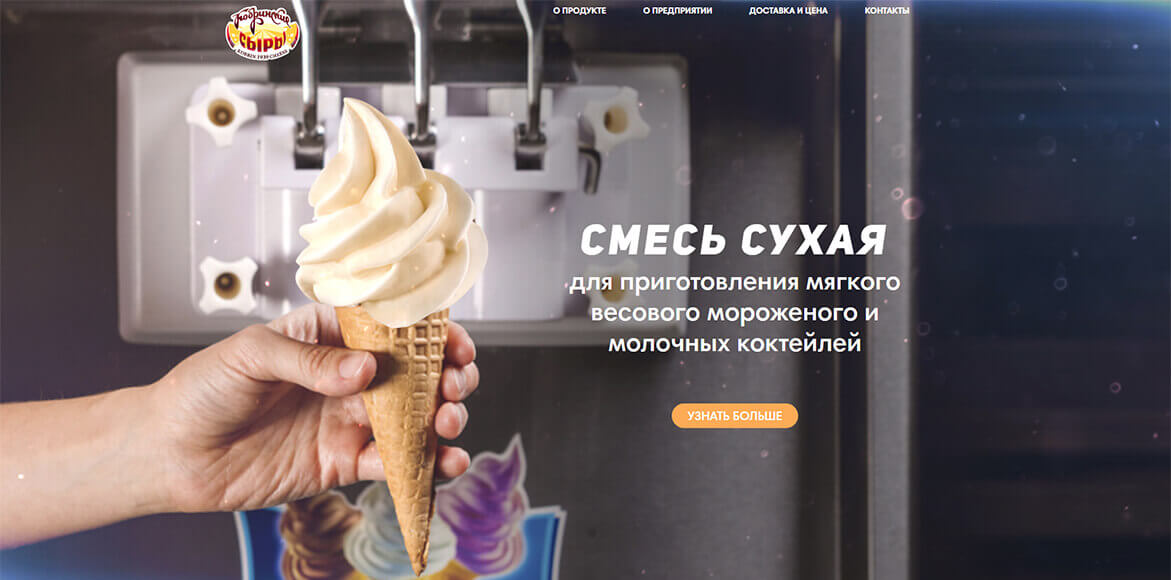There are several classifications of website types. In this article, we will look at the general classification of websites by structure.
1.1 One-page sites
One-page sites — the name itself suggests that these resources consist of one page, but they are quite long. The clearest example of a one-page site is a landing page. The purpose of such sites is to sell one service, one product or service. It should be clear that single-page sites only work for one idea. When you have several ideas or services, it is better to use multi-page sites.
The structure of the Landing Page:
- An attention-grabbing headline.
- Picture, video, slider with banners — visualisation of the offer.
- UTP (unique selling proposition). Information about the product, why this product is worth buying.
- Customer feedback. Previously, this point was spontaneously used in the creation of Web links. Now the audience on the Internet is less receptive to such feedback.
- Feedback — a form for getting contacts of potential buyers and following up with them.
- Button for action: Buy, Order, Checkout, etc.
- Additionally, company details, links to social networks, copyright signs, etc. are placed.
The basic steps in creating a website:
- When creating the design, three layouts are drawn: for a mobile device, a tablet and a PC. Often, mobile traffic accounts for more than 80% of total site visits. Each layout must be implemented in its entirety (correct operation, completeness of information display, usability, etc.).
- Determine how to implement the site. Through a typical layout, website builders, self-written project.
Disadvantages of building a website on ready-made systems (Tilda, Wix and others).
- Typical template.
- The sites are inflexible.
- You will not be able to influence them technically.
- No ability to add your own ideas.
- Forced to use existing functionality, above which you can not step.
- Using such a system has a high cost.
- Difficulties in promoting projects.
An example of a Landing Page.
How do I promote a one-page website?
- A single page or landing page can only be promoted for one product (service). In order to be at the top of the competition Place a keyword in the title bar.
- The length of the title is limited to 70 characters. Anything longer than that will not be understood by the robot. Consequently, it’s difficult to fit several services into one title.
- If you create a page for a particular query, taking into account the requirements of search engines, you fully disclose the idea of the request. As a result, the user’s intent is closed. This is why query clusters exist.
- Landings do not have such a notion as the weight of the site. The weight factor depends on the number of pages. Landing can reach the top only through other factors. To determine whether to reach the top, you need to go to the output of the key you are promoting. Next, you need to see if there are among the leading positions of landing pages. If there is — the system of Yandex and Google will allow landings to fight for the top in this query. Otherwise, the chances are slim.
- If the landing page is on a subdomain, it is more difficult to promote it. The deeper the level, the lower the priority of the page, and the site ranks worse.
- Don’t forget that a landing page can be supported by paid traffic. Often, the landing pages are created to further set up advertising campaigns. Which will generate traffic to your landing page.
1.2 Multi-page
When a company has several services, a separate page is created for each of them. A website can be a consequence of a landing page, where several pages are linked by a main menu. Remember that a full disclosure of an idea does not have to be limited to one page and a minisite.
Site structure:
Factors affecting the promotion of a multi-page website:
- These sites can use homepage optimisation.
- Page weight.
- Internal linking. (Internal linking — pages within a site link to each other. Each link increases the weight of the page).
- Creating a blog.
Having a blog seriously increases the weight of the website. Page sizes increase because of articles, news, etc. Inside the articles you can link to pages on the site. Articles can engage the user to read interesting information and attract additional traffic. And as we remember from the last lesson, the more the visitor is on the site (reading articles, going to new pages) the higher the behavioural factors that search algorithms recognise and raise the site higher in search engine results.
1.3 Websites catalogues
- magazines;
- online shops;
- corporate websites of manufacturing companies.
Corporate website example https://kobrincheese.com/
Structure of catalogue sites
- Main page.
- Subsidiary pages (About Us, History, News, Contacts, etc.).
- A separate tab with a catalogue of products, which are divided into sections, and sections into subsections (in several levels), in subsections are the products themselves.
Magazines and online shops differ only in content: in magazines, it’s articles, and in shops, it’s products. Shops include additional commercial factors which are desirable to implement. For example, in the absence of a shopping cart in a shop, it is impossible to reach the top. At the same time on the site of manufacturing companies do not sell piece products, but work with wholesalers, respectively, prices are not displayed there. The reason for this is the commercial terms of cooperation: the shipment price is different for different countries, the discount depends on the volume, prepayment or deferral, etc.
The main traffic in websites with a catalogue structure is driven by product sections and subsections, which are the ones to be promoted.
Often online shops create internal blogs filled with articles. The articles will accumulate additional traffic to their subject. These may not be direct buyers, but rather a fairly warm audience. A loyal audience that can later become customers and brand advocates.


